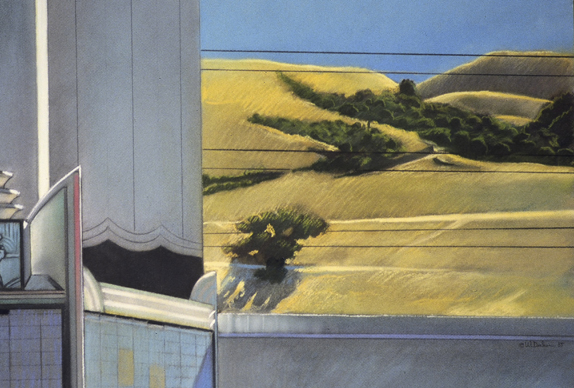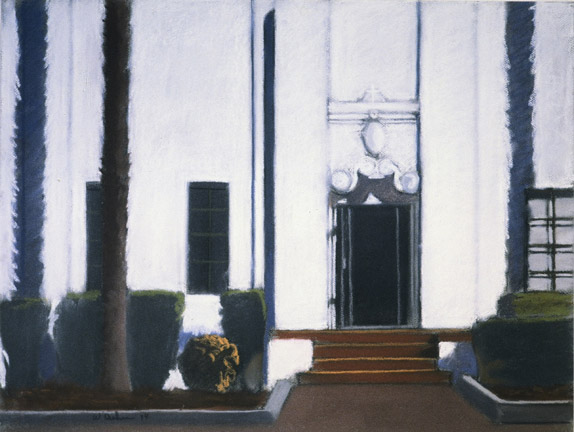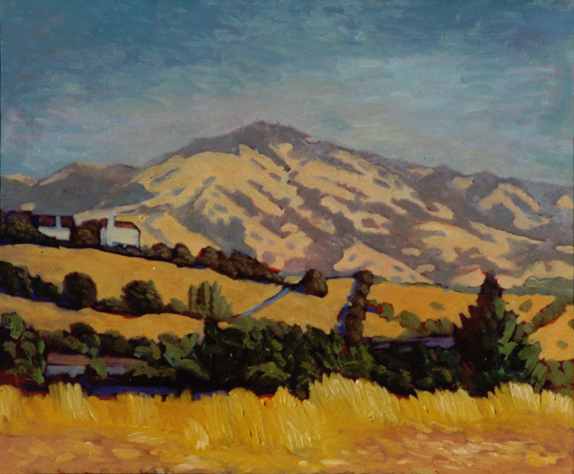|
|
|
Dreher's Love of Color Comes to Light
By Jennifer Modenessi, Contra Costa Times, September 20, 2002
A weather-beaten French easel stands by the front window of the Antioch Lynn House gallery. It holds a wooden palette loaded with colorful layers and mixtures of thick oil paint. Battered oil brushes are tucked into the metal holders, their bristles stained with colors from countless strokes of paint.
There's a powerful stillness to the easel as it stands sentinel over the train tracks and riverfront. It's that quiet power that dominates the new "Warren Dreher Retrospective" at the Antioch Lynn House Gallery.
Dreher, a former curator at the gallery, asked that the easel be included in the show that represents 38 years of his painting life. It is with this type of easel that so many of his plein-air paintings were created.
Plein-air painting is painting done from observation, on location, amid the elements and nature. The French Impressionist movement of the 1800s was full of plein-air painters who set up their easels on seashores, hillsides, parks and cafes and painted colorful images interpreted directly from life. Dreher's work is a modern descendent of this style.
The early work in the retrospective consists mainly of large pastel paintings. Dreher's pastel landscapes are studies in design and color and, in contrast to his later work, are graphic and bold. Dreher concentrates on subjects like the Orinda Theater and the walls of St. Mary's to explore light and color and the way they play on man-made structures and natural forms.
|
 |
 |
|
"Orinda Theatre and Hills," with its strong horizontal and vertical composition and its muted color scheme of turquoise and gold, brings to mind the abstract landscapes of Richard Diebenkorn. The series of studies of the shadows of St. Mary's are direct predecessors to the studies of structures and landscapes in oils. Dreher is preoccupied with light and how it colors and transforms one subject in myriad ways.
Dreher revels in color and his paintings reflect his skill in color theory and complementary color usage. He saturates his canvases with combinations of unexpected yet sophisticated schemes, as in the yellow-orange and blood-burgundy harmony of his serene landscape "Waiting for Keith" and the orange sky, blue shadows and red rooftops of "Sacramento, Noon".
The color in the oil paintings from the early 1990s is a bit truer to life than his latest work, and his series are the perfect formats for him to explore the effects of light.
Dreher says a slide lecture at Saint Mary's College 10 years ago gave him food for thought. "It occurred to me that I had pretty much been doing the same painting my entire life, from different locations," he said.
|
 |
 |
|
His Mt. Diablo and Marin Headlands series are proof of his dedication to exploring the concept of sameness and change. Dreher paints the same subject, Mt. Diablo, in different weather conditions and at different times of the day to record the effects of the elements and light. The same subject changes -- from a hazy Diablo, to a Diablo scorched by the last rays of the sun, to a view "From the Summit of Diablo" where traditional atmospheric perspective is forgone to give an almost Fauvist abstraction to the landscape.
"Marin Headlands, Morning" and "Marin Headlands, Afternoon" focus on the same subject, a seaside house and trees, but differ in their dramatic color schemes and the effect of the sun and light.
The inclusion of some still lifes and portraits demonstrates the breadth of Dreher's skill. They contain the same preoccupation with light and color. One still life, "Red Glass in Studio" arguably exhibits the most "painting" of the paintings as it combines not only strong composition and a dramatic use of vibrant color, but extremely expressive brush strokes. The oil here is thick and fluid and exploits some of the best aspects of the medium.
His "High Winds, Benicia Waterfront" is a landscape that closely carries that same expressiveness. The brush becomes calligraphic and follows the forms of nature. One can sense the clouds scuttling and rolling across the sky and the winds whipping the frothing, churning water.
Dreher's work is often compared to Edward Hopper, the American painter who was famous for his serene landscapes, cityscapes and captured moments of life. In some of Hopper's most moving work, the powerful sense of serenity and place is made more acute by the lack of human presence within the picture. The viewer of the work of art becomes directly involved with the painting as the only human presence.
There's the sense of stumbling upon a place that is both lonely and self-fulfilled. It's a quiet power and something admirable when an artist, amid technical skill, subject matter and painting bravado, is able to convey that. When Dreher sets off to paint a landscape, a bay, Diablo, he does just that.
|
 |
 |
|
|